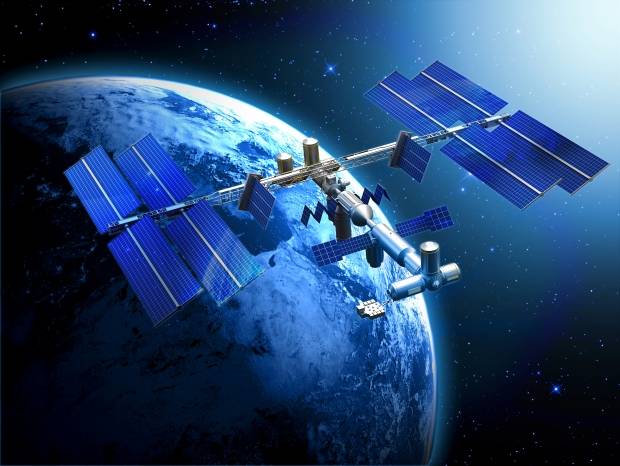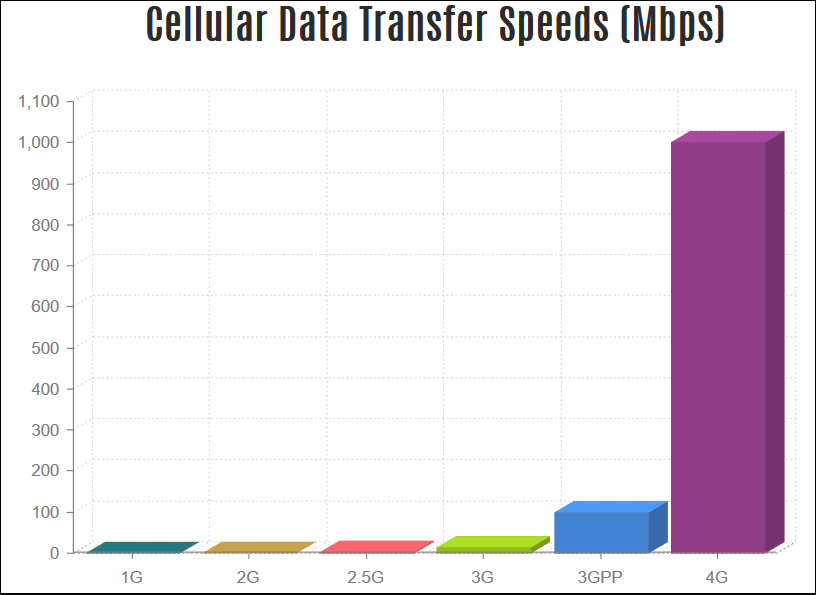




Copyright © Weberica.net.



Your cell phone utilizes a wireless communication system as well. The "cell" part in your phone's name hints at "cellular communication", a system that uses cells (small wireless communication data centers) which are placed in several places throughout the city, communicating with each other and with your cell phone. As people move from one area to another, the closest cell to them will take over communication, ensuring a seamless experience.
The first cellular communication system was implemented in the 80s in the US. Since then, cellular communication has been upgraded to GSM, GPRS, UMTS and LTE. Peak data transfer rates have increased proportionally, boosting speeds from about 8 Kbps to 1,000 Mbps. Here's a Data Alliance graph, which shows the huge speed increase over the years, in an easy to digest form.
The first cellular communication system was implemented in the 80s in the US. Since then, cellular communication has been upgraded to GSM, GPRS, UMTS and LTE. Peak data transfer rates have increased proportionally, boosting speeds from about 8 Kbps to 1,000 Mbps. Here's a Data Alliance graph, which shows the huge speed increase over the years, in an easy to digest form.
An introduction to wireless communications
Did you know that Guglielmo Marconi, an Italian inventor, was the creator of the first long distance radio transmitter? Named "wireless telegraphy", his idea was brought to life in 1894, when he created the first pair of receivers and transmitters in the world.
You would assume that everyone was excited about the new possibilities offered by wireless data transmission, but the truth is that Marconi couldn't find any support in his country. In fact, the Ministry of Post and Telegraphs declared that Marconi was crazy!
Luckily for him, the young Italian inventor was fluent in English as well, and he has managed to get the British government interested in his invention. During a live demonstration, Marconi managed to send Morse code signals wirelessly, over a distance of about 4 miles. That's how the "Telegraph without wires" system was invented.
So, yes, we have been using various types of wireless communications since the end of the 19th century. In fact, any system that is able to transfer information between two places that aren't connected physically (through a wire or a similar connection) transfers data wirelessly.
Believe it or not, most people use wireless devices in their homes every day without even knowing it! Your TV remote uses infrared light that's emitted by a small LED to change the TV channels, for example. And scientists use long-distance wireless systems for space radio communication.
Did you know that Guglielmo Marconi, an Italian inventor, was the creator of the first long distance radio transmitter? Named "wireless telegraphy", his idea was brought to life in 1894, when he created the first pair of receivers and transmitters in the world.
You would assume that everyone was excited about the new possibilities offered by wireless data transmission, but the truth is that Marconi couldn't find any support in his country. In fact, the Ministry of Post and Telegraphs declared that Marconi was crazy!
Luckily for him, the young Italian inventor was fluent in English as well, and he has managed to get the British government interested in his invention. During a live demonstration, Marconi managed to send Morse code signals wirelessly, over a distance of about 4 miles. That's how the "Telegraph without wires" system was invented.
So, yes, we have been using various types of wireless communications since the end of the 19th century. In fact, any system that is able to transfer information between two places that aren't connected physically (through a wire or a similar connection) transfers data wirelessly.
Believe it or not, most people use wireless devices in their homes every day without even knowing it! Your TV remote uses infrared light that's emitted by a small LED to change the TV channels, for example. And scientists use long-distance wireless systems for space radio communication.
Blog



It's not all about cell phones, though. We are now using wireless communications for lots of useful Bluetooth devices. However, wireless local area networks are definitely the most popular implementation of this technology.
Wi-Fi communication uses a router, which is able to communicate wirelessly with its clients: computers, tablets, smart phones, and so on. Most routers are built for home and small office usage. However, the technology is flexible enough, allowing people to add Wi-Fi range extenders, high gain Wi-Fi antennas and signal amplifiers that can extend signal range to several miles.
Manufacturers have chosen the 2.4 GHz band to build Wi-Fi devices, because it was one of the freely available frequency spectrums. Modern routers are able to work using the newer 5 GHz band as well.
The health industry has greatly benefited from wireless medical technologies. It is now easy to monitor heart rates, body temperatures, blood pressure and more by making use of devices that transmit the needed information, without experiencing any of the inconveniences that arise from using wired connections.
It's a bit strange, but some manufacturers have implemented wireless technologies which aren't that good for our planet. I am talking about devices that transfer energy wirelessly, for example. I agree that it's quite convenient to recharge your smartphone wirelessly, but a lot of energy is lost during the process. And this happens while we are striving to conserve our planet, by saving as much energy as possible! Isn't that ironic?
Wireless technologies are here to stay, and they are very likely to improve the quality of our lives. Since the IT industry is progressing fast, the prices of wireless devices are now very affordable. Let's hope that manufacturers will also pay attention to the potential dangers of RF radiation. Another important issue that needs to be addressed is data security. People should continue to use wired connections to transfer and store sensitive data whenever it is possible to do so.
Wi-Fi communication uses a router, which is able to communicate wirelessly with its clients: computers, tablets, smart phones, and so on. Most routers are built for home and small office usage. However, the technology is flexible enough, allowing people to add Wi-Fi range extenders, high gain Wi-Fi antennas and signal amplifiers that can extend signal range to several miles.
Manufacturers have chosen the 2.4 GHz band to build Wi-Fi devices, because it was one of the freely available frequency spectrums. Modern routers are able to work using the newer 5 GHz band as well.
The health industry has greatly benefited from wireless medical technologies. It is now easy to monitor heart rates, body temperatures, blood pressure and more by making use of devices that transmit the needed information, without experiencing any of the inconveniences that arise from using wired connections.
It's a bit strange, but some manufacturers have implemented wireless technologies which aren't that good for our planet. I am talking about devices that transfer energy wirelessly, for example. I agree that it's quite convenient to recharge your smartphone wirelessly, but a lot of energy is lost during the process. And this happens while we are striving to conserve our planet, by saving as much energy as possible! Isn't that ironic?
Wireless technologies are here to stay, and they are very likely to improve the quality of our lives. Since the IT industry is progressing fast, the prices of wireless devices are now very affordable. Let's hope that manufacturers will also pay attention to the potential dangers of RF radiation. Another important issue that needs to be addressed is data security. People should continue to use wired connections to transfer and store sensitive data whenever it is possible to do so.